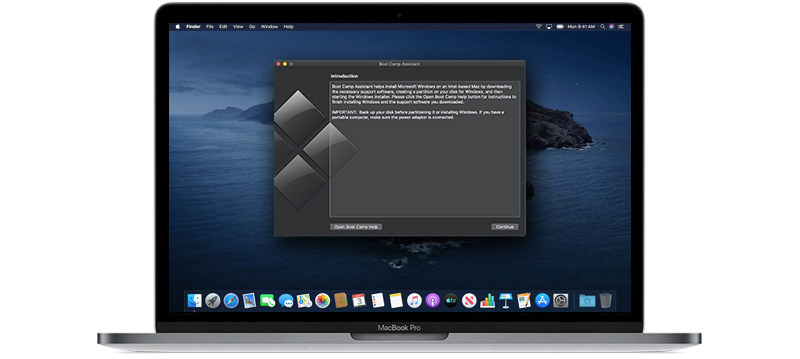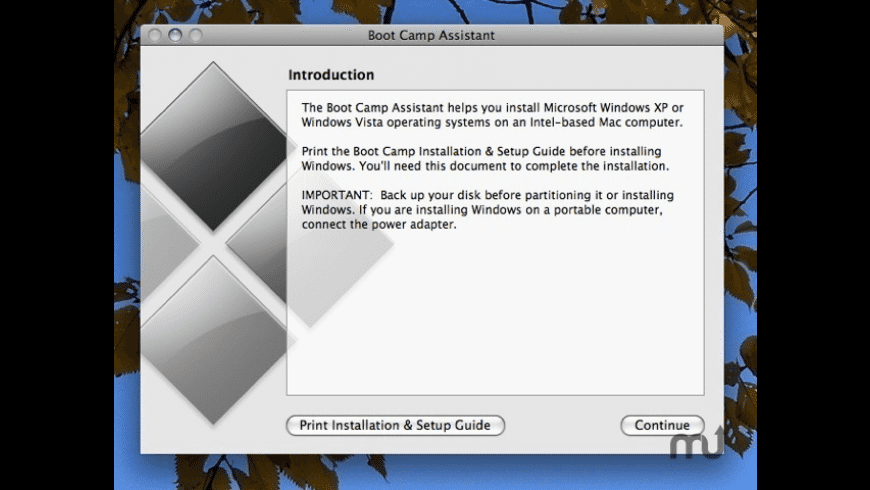
This article over on the Apple KB has links to some driver/software updates for Windows 7, but the drivers are from Bootcamp 3.2. This is the direct link to the Bootcamp drivers for x64. Even though you are not running a Mac, the Bootcamp drivers will install regardless. I have a 2010 Macbook Pro with Snow Leopard (10.6.8) installed and couldn't get the right Boot Camp upgrade using any of the Apple download software from within the bootcamp Application. After installing this Update/Upgrade suddenly all of the required drivers appeared in the Windows 'Device manager' and everything started working perfectly. Supported Systems Name Description Revision Number File Size Release Date Download Link Mac Pro (2019) with Radeon Pro 580x, Radeon Pro Vega II and Radeon Pro W5700X / W5500X MacBook Pro (Retina, 16-inch, 2019) with Radeon Pro 5300M and 5500M MacBook Pro (Retina, 15-inch, 2015-Present) iMac (Retina 4K, 21.5-inch, 2017-Present) iMac (Retina 5K, 27-inch, 2014-2019).
You can use Boot Camp Assistant to install Windows 10 on your Intel-based Mac.

Newer Mac computers use a streamlined method to install Windows on your Mac. To find out whether your Mac uses this method, see the 'Learn more' section in the Apple Support article Install Windows 10 on your Mac with Boot Camp Assistant. If your Mac is an older model that requires an external USB drive, follow the instructions in Install Windows on your older Mac using Boot Camp instead.
What you need

The keyboard and mouse or trackpad that came with your Mac. If they aren't available, use a USB keyboard and mouse.
A full-installation, 64-bit version of Windows 10 on a disk image (ISO file) or other installation media.
You can download a Windows 10 Disc Image (ISO File) from Microsoft.
Sufficient free storage space on your startup drive. For information about the amount of free space needed, see the Apple Support Article Install Windows 10 on your Mac with Boot Camp Assistant.
Before you begin
Before you install Windows, make sure you back up important files.
You can use Time Machine or any other method to back up your files. For information about backing up files, see Back up your files with Time Machine and Ways to back up or protect your files.
Perform the installation
On your Mac, do the following steps in order.
Step 1: Check for software updates
Before you install Windows, install all macOS updates.
On your Mac, log in as an administrator, quit all open apps, then log out any other users.
Choose Apple menu > System Preferences, click Software Update, then install all available macOS updates.
If your Mac restarts after installing an update, open Software Update again to install any additional updates.
Step 2: Prepare your Mac for Windows
Boot Camp Assistant prepares your Mac by creating a new partition for Windows named BOOTCAMP and downloading the Boot Camp support software.
Important: If you're using a Mac notebook computer, connect it to a power source before continuing.
On your Mac, open Boot Camp Assistant , located in /Applications/Utilities.
At the Introduction screen, click Continue.
The system is checked for total available disk space. Older Time Machine snapshots and cached iCloud files are removed to make space for Boot Camp. This process may take a long time to complete (you can click the Stop button to skip this process).
If you have only one internal disk, choose the Windows ISO image, specify the partition size by dragging the divider between the macOS and Windows partitions, then click Install.
If you have multiple internal disks, follow the onscreen instructions to select and format the disk you want to install Windows on and to choose the Windows ISO image.
If you select your startup disk: You can create an additional partition for Windows. Specify the partition size by dragging the divider between the macOS and Windows partitions.
If you select an APFS-formatted disk: You can either create an additional partition on the disk for Windows, or erase the entire disk and create a partition for Windows. If you choose to create an additional partition, specify the partition size by dragging the divider between the macOS and Windows partitions.
If you select a non-APFS-formatted disk: You can erase the entire disk and create a partition for Windows.
If Boot Camp is already present on the disk you select, you also have the option to uninstall it.
Important: Download mojave installer dmg ubuntu. You can't resize the partition later.
When this step is complete, the Windows installer starts.
Step 3: Install Windows

- Apple Bootcamp Drivers Download
- Apple Bootcamp Drivers Download Windows 10
- Apple Bootcamp Drivers Download
- Apple Bootcamp Drivers Download Windows 10
- Apple Bootcamp Drivers Download Windows 10
Boot Camp Assistant User Guide
This article over on the Apple KB has links to some driver/software updates for Windows 7, but the drivers are from Bootcamp 3.2. This is the direct link to the Bootcamp drivers for x64. Even though you are not running a Mac, the Bootcamp drivers will install regardless. I have a 2010 Macbook Pro with Snow Leopard (10.6.8) installed and couldn't get the right Boot Camp upgrade using any of the Apple download software from within the bootcamp Application. After installing this Update/Upgrade suddenly all of the required drivers appeared in the Windows 'Device manager' and everything started working perfectly. Supported Systems Name Description Revision Number File Size Release Date Download Link Mac Pro (2019) with Radeon Pro 580x, Radeon Pro Vega II and Radeon Pro W5700X / W5500X MacBook Pro (Retina, 16-inch, 2019) with Radeon Pro 5300M and 5500M MacBook Pro (Retina, 15-inch, 2015-Present) iMac (Retina 4K, 21.5-inch, 2017-Present) iMac (Retina 5K, 27-inch, 2014-2019).
You can use Boot Camp Assistant to install Windows 10 on your Intel-based Mac.
Newer Mac computers use a streamlined method to install Windows on your Mac. To find out whether your Mac uses this method, see the 'Learn more' section in the Apple Support article Install Windows 10 on your Mac with Boot Camp Assistant. If your Mac is an older model that requires an external USB drive, follow the instructions in Install Windows on your older Mac using Boot Camp instead.
What you need
The keyboard and mouse or trackpad that came with your Mac. If they aren't available, use a USB keyboard and mouse.
A full-installation, 64-bit version of Windows 10 on a disk image (ISO file) or other installation media.
You can download a Windows 10 Disc Image (ISO File) from Microsoft.
Sufficient free storage space on your startup drive. For information about the amount of free space needed, see the Apple Support Article Install Windows 10 on your Mac with Boot Camp Assistant.
Before you begin
Before you install Windows, make sure you back up important files.
You can use Time Machine or any other method to back up your files. For information about backing up files, see Back up your files with Time Machine and Ways to back up or protect your files.
Perform the installation
On your Mac, do the following steps in order.
Step 1: Check for software updates
Before you install Windows, install all macOS updates.
On your Mac, log in as an administrator, quit all open apps, then log out any other users.
Choose Apple menu > System Preferences, click Software Update, then install all available macOS updates.
If your Mac restarts after installing an update, open Software Update again to install any additional updates.
Step 2: Prepare your Mac for Windows
Boot Camp Assistant prepares your Mac by creating a new partition for Windows named BOOTCAMP and downloading the Boot Camp support software.
Important: If you're using a Mac notebook computer, connect it to a power source before continuing.
On your Mac, open Boot Camp Assistant , located in /Applications/Utilities.
At the Introduction screen, click Continue.
The system is checked for total available disk space. Older Time Machine snapshots and cached iCloud files are removed to make space for Boot Camp. This process may take a long time to complete (you can click the Stop button to skip this process).
If you have only one internal disk, choose the Windows ISO image, specify the partition size by dragging the divider between the macOS and Windows partitions, then click Install.
If you have multiple internal disks, follow the onscreen instructions to select and format the disk you want to install Windows on and to choose the Windows ISO image.
If you select your startup disk: You can create an additional partition for Windows. Specify the partition size by dragging the divider between the macOS and Windows partitions.
If you select an APFS-formatted disk: You can either create an additional partition on the disk for Windows, or erase the entire disk and create a partition for Windows. If you choose to create an additional partition, specify the partition size by dragging the divider between the macOS and Windows partitions.
If you select a non-APFS-formatted disk: You can erase the entire disk and create a partition for Windows.
If Boot Camp is already present on the disk you select, you also have the option to uninstall it.
Important: Download mojave installer dmg ubuntu. You can't resize the partition later.
When this step is complete, the Windows installer starts.
Step 3: Install Windows
In the Windows installer, follow the onscreen instructions.
When the installation is finished, your Mac automatically restarts using Windows.
Follow the onscreen instructions to set up Windows.
Step 4: Install Boot Camp on Windows
After installing Windows, Boot Camp drivers that support your Mac hardware start installing.
Note: If the support software doesn't install automatically, you need to install it manually. For instructions, see the Apple Support article If the Boot Camp installer doesn't open after using Boot Camp Assistant.
In the Boot Camp installer in Windows, follow the onscreen instructions.
Important: Do not click the Cancel button in any of the installer dialogs.
If a message appears that says the software you're installing has not passed Windows Logo testing, click Continue Anyway.
Cannot find mojave in app store. You don't need to respond to installer dialogs that appear only briefly during installation, but if a dialog asks you to install device software, click Install.
If nothing appears to be happening, there may be a hidden window that you must respond to. Look behind open windows.
When the installation is complete, click Finish.
After your Mac restarts, follow the instructions for any other installers that appear.
Apple Bootcamp Drivers Download
Hi, I successfully wiped the SSD and loaded Windows 10 on my MacBook Pro Retina 2012, but now I can't find the drivers anywhere. Where can I get these drivers and why do you make it so difficult for your customers? any other make/model I go to the site, type in my model name/number and boom all drivers available. Pay a lot more for a macbook and get nothing.
Apple Bootcamp Drivers Download Windows 10
Apple Bootcamp Drivers Download
so many threads asking the same question and always pointed to bootcamp assistant in osx. I don't have or want osx, just windows on this awesome retina screen.
Apple Bootcamp Drivers Download Windows 10
MacBook Pro (Retina, Mid 2012), OS X El Capitan (10.11.1)
Apple Bootcamp Drivers Download Windows 10
Posted on Jul 29, 2016 7:06 PM
